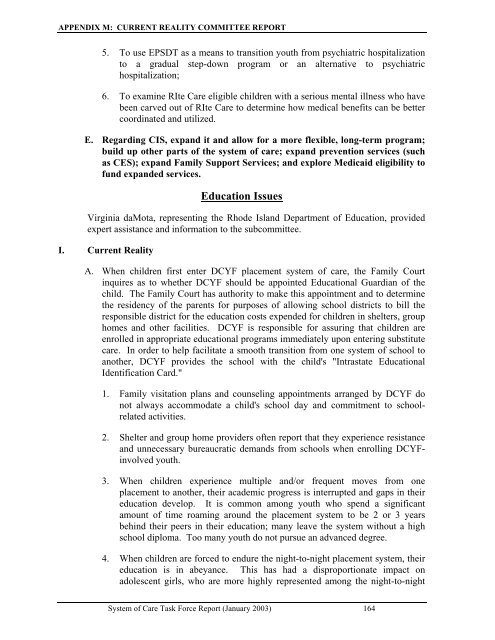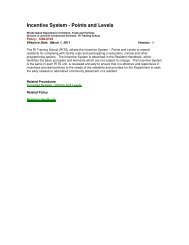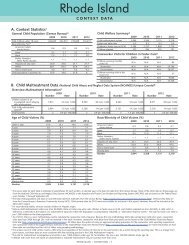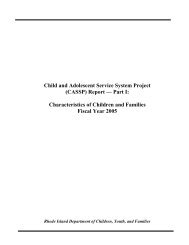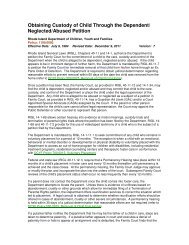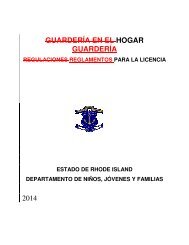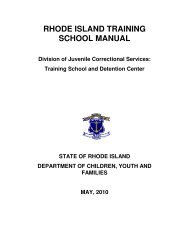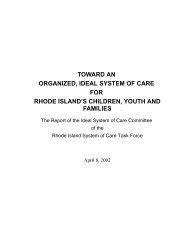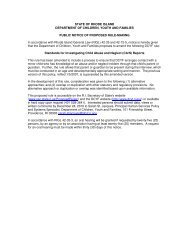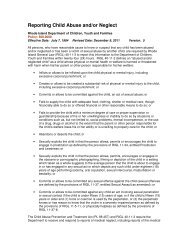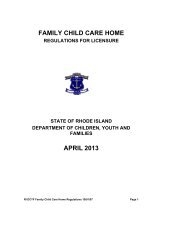Final Report - RI Department of Children, Youth & Families
Final Report - RI Department of Children, Youth & Families
Final Report - RI Department of Children, Youth & Families
You also want an ePaper? Increase the reach of your titles
YUMPU automatically turns print PDFs into web optimized ePapers that Google loves.
APPENDIX M: CURRENT REALITY COMMITTEE REPORT<br />
5. To use EPSDT as a means to transition youth from psychiatric hospitalization<br />
to a gradual step-down program or an alternative to psychiatric<br />
hospitalization;<br />
6. To examine <strong>RI</strong>te Care eligible children with a serious mental illness who have<br />
been carved out <strong>of</strong> <strong>RI</strong>te Care to determine how medical benefits can be better<br />
coordinated and utilized.<br />
E. Regarding CIS, expand it and allow for a more flexible, long-term program;<br />
build up other parts <strong>of</strong> the system <strong>of</strong> care; expand prevention services (such<br />
as CES); expand Family Support Services; and explore Medicaid eligibility to<br />
fund expanded services.<br />
Education Issues<br />
Virginia daMota, representing the Rhode Island <strong>Department</strong> <strong>of</strong> Education, provided<br />
expert assistance and information to the subcommittee.<br />
I. Current Reality<br />
A. When children first enter DCYF placement system <strong>of</strong> care, the Family Court<br />
inquires as to whether DCYF should be appointed Educational Guardian <strong>of</strong> the<br />
child. The Family Court has authority to make this appointment and to determine<br />
the residency <strong>of</strong> the parents for purposes <strong>of</strong> allowing school districts to bill the<br />
responsible district for the education costs expended for children in shelters, group<br />
homes and other facilities. DCYF is responsible for assuring that children are<br />
enrolled in appropriate educational programs immediately upon entering substitute<br />
care. In order to help facilitate a smooth transition from one system <strong>of</strong> school to<br />
another, DCYF provides the school with the child's "Intrastate Educational<br />
Identification Card."<br />
1. Family visitation plans and counseling appointments arranged by DCYF do<br />
not always accommodate a child's school day and commitment to schoolrelated<br />
activities.<br />
2. Shelter and group home providers <strong>of</strong>ten report that they experience resistance<br />
and unnecessary bureaucratic demands from schools when enrolling DCYFinvolved<br />
youth.<br />
3. When children experience multiple and/or frequent moves from one<br />
placement to another, their academic progress is interrupted and gaps in their<br />
education develop. It is common among youth who spend a significant<br />
amount <strong>of</strong> time roaming around the placement system to be 2 or 3 years<br />
behind their peers in their education; many leave the system without a high<br />
school diploma. Too many youth do not pursue an advanced degree.<br />
4. When children are forced to endure the night-to-night placement system, their<br />
education is in abeyance. This has had a disproportionate impact on<br />
adolescent girls, who are more highly represented among the night-to-night<br />
System <strong>of</strong> Care Task Force <strong>Report</strong> (January 2003) 164


